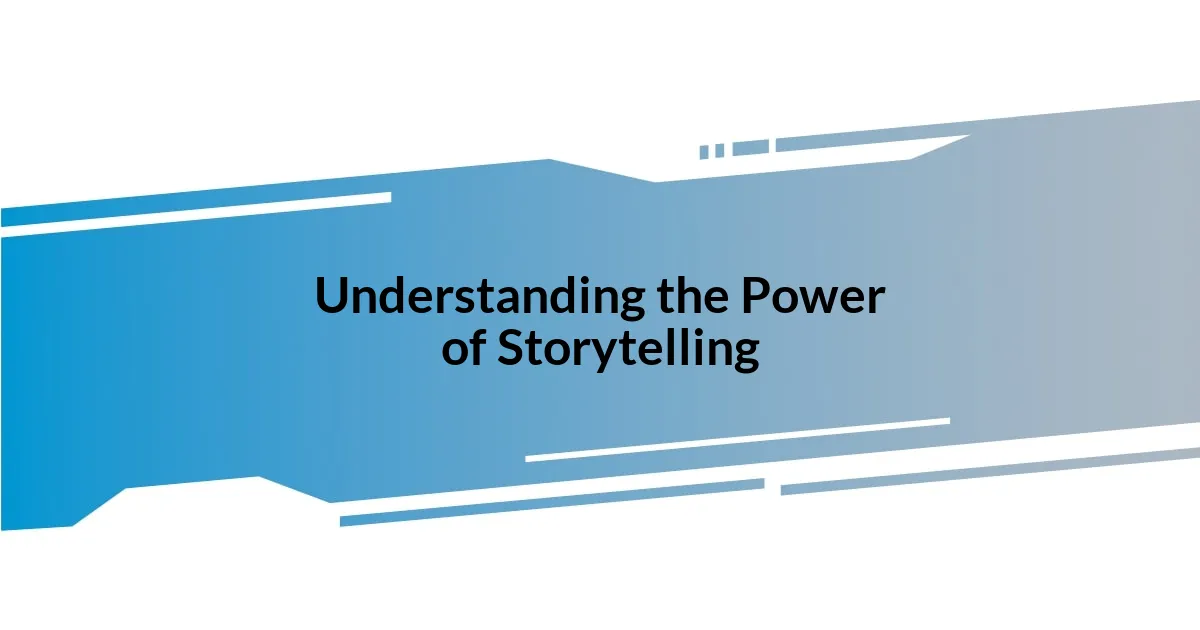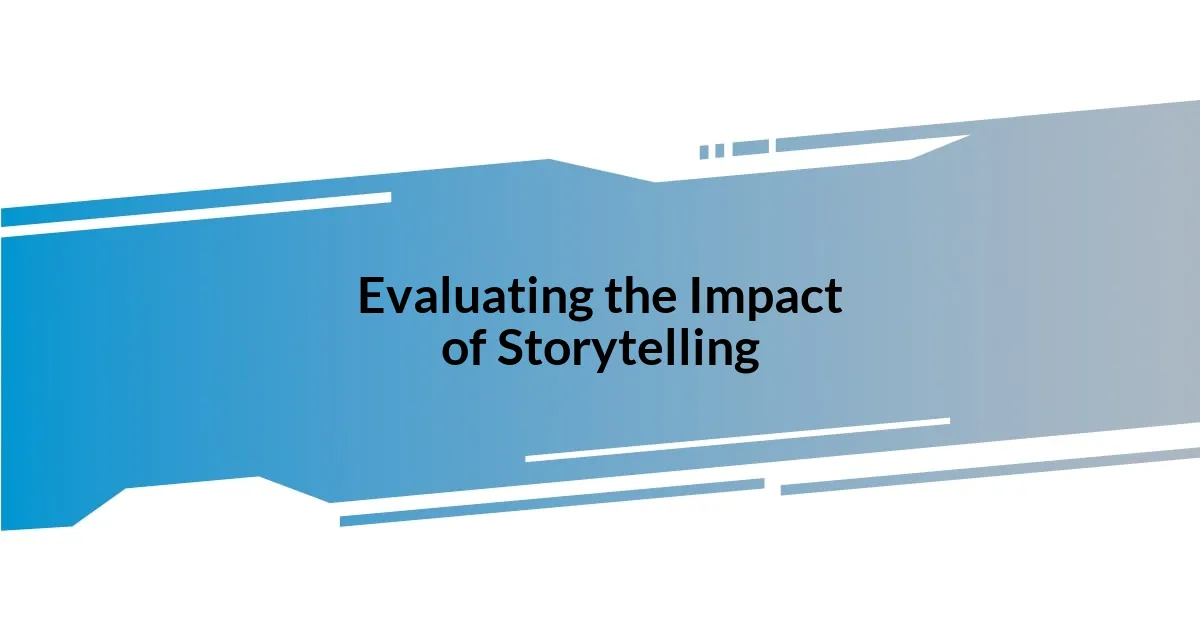Key takeaways:
- Storytelling fosters genuine connections by making complex ideas relatable and exploring values through personal narratives.
- Key elements for effective storytelling include an emotional arc, relatable characters, and an engaging setting to enhance audience interaction.
- Adapting stories to different audiences ensures relevance and emotional resonance, transforming lessons into impactful experiences.
- Continual improvement of storytelling skills involves practice, analysis of others’ narratives, and seeking constructive feedback for growth.

Understanding the Power of Storytelling
Storytelling is a powerful tool that transcends mere entertainment; it shapes our understanding and connects us on a human level. I remember a time in my own life when a story shared by a mentor completely shifted my perspective on failure. Hearing how they navigated challenges made their lessons stick, showing me that vulnerability in storytelling fosters genuine connections.
Have you ever noticed how a well-told story can make complex ideas feel simpler? I’ve found that when I weave personal experiences into my lessons, the audience not only listens but genuinely relates. It’s like a bridge formed between the speaker and the listener, creating an emotional resonance that facts and figures often lack.
Consider how storytelling allows us to explore values and beliefs in ways that resonate deeply. I often reflect on moments from my childhood that taught me resilience, and I use those memories to illustrate concepts in my lessons. Each story becomes a vessel for lessons learned, inviting my audience to engage with the material on a deeper level. Isn’t it remarkable how a simple narrative can unlock profound insights?

Crafting Engaging Storylines
Crafting engaging storylines requires a delicate balance of structure and spontaneity. When I create a storyline, I often think about the emotional arc—how it starts, builds up, and resolves. Recently, I recounted a challenging hike I took, where every misstep taught me something valuable. That journey through uncertainty not only painted a vivid picture but also allowed my audience to feel the tension and triumph along the way.
I’ve learned that characters are the heart of any story. When I introduce relatable characters, such as my high school self grappling with self-doubt, my audience immediately connects. They see parts of themselves in those characters, fostering engagement. I often ask, “How would you handle that situation?” This question invites reflection and participation, making the story more interactive.
Moreover, I’m convinced that setting influences storytelling significantly. I once described a bustling café where I first encountered the joy of teamwork during a group project. The café’s sights, sounds, and smells constructed a backdrop that made my experience richer. These details not only transport the audience into the story but also energize them, enhancing the overall impact of the lessons conveyed.
| Key Element | Example from Experience |
|---|---|
| Emotional Arc | Describing a challenging hike where I faced uncertainty and learned valuable lessons. |
| Character Development | Introducing my high school self battling self-doubt, inviting reflection and connection. |
| Setting | A lively café scene where teamwork flourished, adding richness to the narrative. |

Integrating Stories into Lesson Plans
Integrating stories into lesson plans can transform the learning experience. I often find that weaving a narrative into a lesson creates a dynamic environment. For instance, when discussing the importance of teamwork, I share a moment from a college project where our diverse opinions led to unexpected solutions. The laughter and struggles shared in that experience illustrate group dynamics and make the concept more relatable.
When planning my lessons, I focus on the following elements to seamlessly incorporate storytelling:
-
Relatable Characters: I draw from real-life encounters, like my experience leading a community service project. This allows students to connect with the challenges and triumphs of the characters in the story.
-
Emotional Context: I emphasize the feelings involved, such as the excitement I felt when we achieved our goal despite setbacks. This emotional backdrop deepens engagement and understanding.
-
Interactive Elements: Including moments for student participation, like discussing their own stories or opinions, fosters a collaborative atmosphere. This approach not only enriches the lesson but encourages personal investment in the material.
These strategies can dramatically enhance the effectiveness of any lesson plan, making learning not just informative but memorable and impactful.

Techniques for Effective Delivery
To truly captivate an audience, I focus on my vocal delivery. I remember a time when I recounted a story about a job interview that went hilariously wrong. I varied my pitch and tempo to mirror the tension and relief of that experience. It’s incredible how a well-timed pause or an enthusiastic exclamation can draw listeners in, keeping them on the edge of their seats.
Physical presence also plays a crucial role in storytelling. During a workshop, I once engaged the participants by moving around the room, emphasizing key moments in my story through gestures. This movement not only breaks any monotony but also reinforces the emotional stakes—each hand movement added a layer of connection. I often wonder, how does your body language impact your storytelling? For me, it transforms the narrative from mere words to a vivid scene.
Finally, I find that visual aids can enhance the storytelling experience significantly. When recounting my adventures hiking a challenging trail, I used photos to illustrate the beauty and struggle of the journey. These images served as visual bookmarks, anchoring my audience in that moment. Have you ever noticed how a single image can evoke a wave of emotions? Integrating visuals keeps the lessons memorable and resonates deeply with listeners.

Adapting Stories for Different Audiences
It’s fascinating how the same story can resonate differently with diverse audiences. For instance, I once tailored the same tale about overcoming failure for two distinct groups: high school students and corporate professionals. With the students, I focused more on humor and relatable teenage insecurities, while with the professionals, I emphasized strategic decision-making and lessons learned that could apply to their careers. Each audience sparked different responses, highlighting the importance of considering their unique perspectives and experiences.
When it comes to younger audiences, simplicity often triumphs. I recall a storytelling session with a group of elementary school kids, where I transformed a complex moral lesson into a whimsical tale featuring talking animals. The way their eyes lit up at each twist and turn reminded me of the value of imagination in learning. On the other hand, when I spoke to a group of educators, I shared a more nuanced narrative that incorporated educational theories. This shift in storytelling style allowed each group to connect with the content meaningfully.
Ultimately, the goal is to create an emotional bridge between the story and the audience. I’ve seen how engaging an audience’s personal experiences can foster authentic connections. For example, after sharing a heartfelt story about my grandmother’s resilience during hard times, several audience members expressed how it mirrored their own family histories. Isn’t it incredible how a single story can unlock so many shared experiences? Adapting your storytelling approach can transform a lesson from merely informative to deeply impactful.

Evaluating the Impact of Storytelling
Evaluating the impact of storytelling is an essential step in understanding its effectiveness. I often reflect on how a story can spark the “aha” moment for someone. For instance, during a seminar, I shared a personal tale about my struggles with imposter syndrome. I could see participants nodding in recognition, their expressions shifting from skepticism to understanding. It’s amazing how a single narrative can create that kind of connection, isn’t it?
One of the most telling measures of storytelling’s impact is audience engagement. I remember a workshop where I shared a story about my first public speaking experience, complete with my nervous mishaps. Afterward, several participants approached me, eager to share their own experiences. This exchange illustrated how storytelling not only engages but also inspires others to reflect on their journeys. How often do we come across an opportunity that encourages vulnerability and connection?
Lastly, feedback is invaluable in evaluating storytelling’s impact. After one presentation, I distributed quick surveys and noticed a significant uptick in attendees’ enthusiasm for the material. They didn’t just remember the facts; they remembered the stories. This reinforces the idea that narratives can shape perceptions and inspire action. Have you ever thought about how your stories could elicit similar responses? It’s all about creating a lasting impression through shared human experiences.

Continual Improvement of Storytelling Skills
Improving my storytelling skills is a journey I embrace wholeheartedly. I’ve discovered that practice is crucial, and I make a habit of sharing stories in casual settings, like during family gatherings or while catching up with friends. Seeing how they react helps me refine my delivery. Have you ever noticed how a slight change in tone or pacing can completely alter the audience’s perception? I find it exhilarating to experiment with different styles and observe the results.
Another method I use to enhance my storytelling is analyzing the narratives of others. I love revisiting TED Talks or reading memoirs, and I often pause to reflect on what makes those stories compelling. For instance, I once dissected the way a speaker seamlessly wove personal anecdotes with universal truths. This sparked an idea for my own storytelling, leading me to incorporate layered meanings that resonate with a variety of listeners. It’s surprising how much we can learn by simply being attentive to the art of others.
Feedback is a game changer in my continual improvement process. After one storytelling session, I invited honest critiques from peers, which was both nerve-wracking and enlightening. Their insights revealed blind spots I hadn’t considered. They pointed out that my stories could benefit from deeper emotional context, something I took to heart. Isn’t it fascinating how valuable external perspectives can elevate our craft? I now seek feedback regularly, knowing that each piece of advice nudges me closer to mastery.